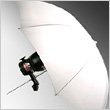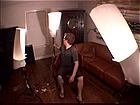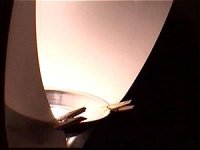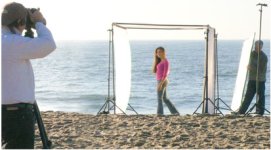Ankou
Quick tips for those of you photographing your artwork...
Had a few minutes this morning, and thought I'd start a thread for those who might need a few tips here and there on recording their artwork. Please feel free to add to or dispute a statement. Just thought this might be useful to someone.
Always set a head on shot for 2D works preferably using an easle for the art and a tripod (or stool of fixed stand of somekind) for the camera. For 3D works a slight angle is usually best. Shoot several angles to find what works best for you and crop the edges to square (assuming it's on a 2D base).
The best light an amature can get is sunlight on a slightly overcast day, not too bright or yellow. A good overcast day will produce a diffused white light evenly across the art work. Flash is just a pain to deal with as is the average indoor lighting situation. If you need to use a flash, try using a layer or three of tracing paper to diffuse the light.
Set up a station, and just shoot one piece after the other. Take several shots, adjusting and tweaking your camera until you get the look you want and write those settings down for future use.
If your using digital, check it in the computer on the printer after the first piece is shot, so you know in real time what the image will look like in it's end product. If your using film, take good notes, because you'll have to do at least two seperate days.
Developing is worth paying for in film. If your shooting artwork on film, I highly recommend going to a small private owned photo developer (trained photographers w/ day jobs ). A well shot photo means nothing if the developing is poor quality.
). A well shot photo means nothing if the developing is poor quality.
Digital prints have a mess a variables to deal with, and a little research will get you a long way. The type of printer you buy, the paper quality, the file format your shooting in, the resolution your shooting, and what program your pushing it all through. Color matching your screen to your printer.... It goes on and on. Again, if you don't have good equipment at home, you might want to take it to a professional for printing.
Thats it, hope its of some help. If not then I invite others to be of more help
Cheers,
Ankou
[edited for clarity, probally not for the last time ]
]
Had a few minutes this morning, and thought I'd start a thread for those who might need a few tips here and there on recording their artwork. Please feel free to add to or dispute a statement. Just thought this might be useful to someone.
Always set a head on shot for 2D works preferably using an easle for the art and a tripod (or stool of fixed stand of somekind) for the camera. For 3D works a slight angle is usually best. Shoot several angles to find what works best for you and crop the edges to square (assuming it's on a 2D base).
The best light an amature can get is sunlight on a slightly overcast day, not too bright or yellow. A good overcast day will produce a diffused white light evenly across the art work. Flash is just a pain to deal with as is the average indoor lighting situation. If you need to use a flash, try using a layer or three of tracing paper to diffuse the light.
Set up a station, and just shoot one piece after the other. Take several shots, adjusting and tweaking your camera until you get the look you want and write those settings down for future use.
If your using digital, check it in the computer on the printer after the first piece is shot, so you know in real time what the image will look like in it's end product. If your using film, take good notes, because you'll have to do at least two seperate days.
Developing is worth paying for in film. If your shooting artwork on film, I highly recommend going to a small private owned photo developer (trained photographers w/ day jobs
Digital prints have a mess a variables to deal with, and a little research will get you a long way. The type of printer you buy, the paper quality, the file format your shooting in, the resolution your shooting, and what program your pushing it all through. Color matching your screen to your printer.... It goes on and on. Again, if you don't have good equipment at home, you might want to take it to a professional for printing.
Thats it, hope its of some help. If not then I invite others to be of more help
Cheers,
Ankou
[edited for clarity, probally not for the last time






